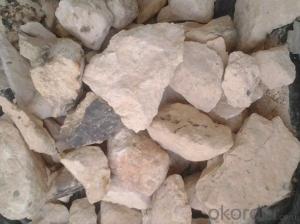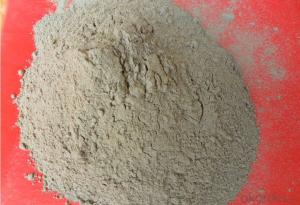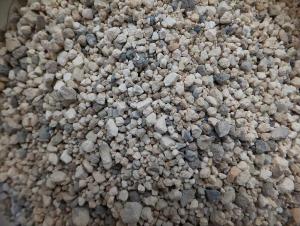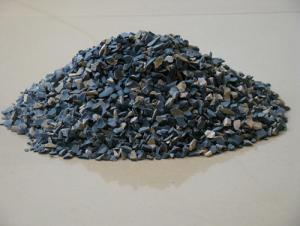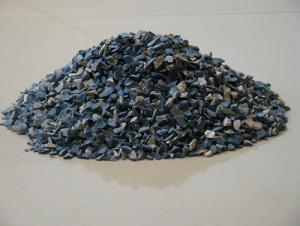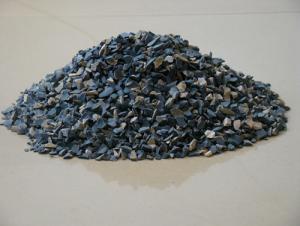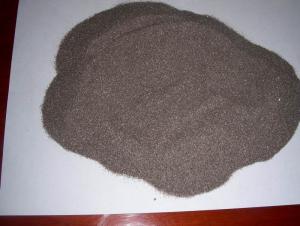China Natural Refractory Calcined Bauxite Low Price with Detailed Specifications
- Loading Port:
- Tianjin
- Payment Terms:
- TT or LC
- Min Order Qty:
- 111 m.t
- Supply Capability:
- 11111111 m.t/month
OKorder Service Pledge
OKorder Financial Service
You Might Also Like
1.Structure of Calcined Bauxite Description
Bauxite (aluminous soil; Bauxite) is also called the alumina or bauxite, main ingredients are alumina, hydrated alumina containing impurities, is an earthy mineral. White or gray, brown and yellow or light red by iron. From 4 to 3.9 g/cm3 density, hardness, 1 ~ 3 is not transparent, very brittle. Very difficult to melt. Insoluble in water, soluble in sulfuric acid, sodium hydroxide solution. Mainly used for aluminium, refractory material.
2.Main Features of the Calcined Bauxite
Calcined bauxite is one of the principal ore of aluminum. Calcined bauxite contains hydrous aluminum oxides and aluminum
hydroxides, formed through the laterization of aluminous rocks in tropical and subtropical areas .Calcined bauxite is obtained by calcining (heating)superior grade bauxite at high temperature (from 85OC to 1600C) .This removes moisture there.By increasing the alumina content,compared to an alumina content of about 57%to 58% in raw bauxite, calcined bauxite has an alumina content of 84%to88%.The heating is carried out in rotary kilns.
3.Main usage of the Calcined Bauxite
(1) aluminium industry. Used in national defense, aerospace, automotive, electronics, chemical industry, daily necessities, etc.
(2) precision casting. Alumina clinker made after the mould precision casting processed into fine powder. Used in military industry, aerospace, communications, instrumentation, machinery and medical equipment department.
(3) is used for refractory products. High bauxite clinker refractoriness is as high as 1780, chemical stability strong, and good physical properties.
(4) aluminum silicate refractory fiber. With light weight, high temperature resistance, good thermal stability, low thermal conductivity, heat capacity is small and the advantages of resistance to mechanical shock. Used in iron and steel, nonferrous metallurgy, electronics, petroleum, chemical, aerospace, atomic energy, defense and other industries.
(5) in magnesia and bauxite clinker as raw materials, add the appropriate binder, used for pouring ladle whole ladle lining has particularly good effects.
(6) manufacture alumina cement, abrasive materials, ceramic industry and chemical industry can be aluminum of various compound.
4. Calcined Bauxite Images

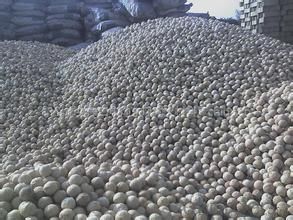
5. Calcined Bauxite Specification
Grade | AL2O3 | SIO2 | FE2O3 | TIO2 | K2O+Na2O | CaO+MgO | Bulk density |
HX75 | 75min | ≤17 | ≤3.0 | ≤4.0 | ≤0.3 | ≤0.5 | ≥2.70 |
HX80 | 80min | ≤12 | ≤3.0 | ≤4.0 | ≤0.3 | ≤0.5 | ≥2.80 |
HX85 | 85min | ≤8 | ≤2 | ≤4.0 | ≤0.3 | ≤0.5 | ≥3.00 |
HX86 | 86min | ≤7 | ≤2 | ≤4.0 | ≤0.3 | ≤0.5 | ≥3.10 |
HX87 | 87min | ≤6 | ≤2 | ≤4.0 | ≤0.3 | ≤0.5 | ≥3.20 |
HX88 | 88min | ≤5 | ≤1.8 | ≤4.0 | ≤0.25 | ≤0.5 | ≥3.25 |
HX90 | 90min | ≤3 | ≤1.8 | ≤4.0 | ≤0.25 | ≤0.5 | ≥3.3 |
Moisture(max) | 0.50% | ||||||
6.FAQ of Calcined Bauxite
1). Q: Are you a factory or trading company?
A: We are a factory.
2). Q: Where is your factory located? How can I visit there?
A: Our factory is located in ShanXi, HeNan, China. You are warmly welcomed to visit us!
3). Q: How can I get some samples?
A: Please connect me for samples
4). Q: Can the price be cheaper?
A: Of course, you will be offered a good discount for big amount.
- Q:What's the refractoriness and how to measure the refractoriness?
- Bottom each side length is 8 mm and upper side length is 2 mm. Under a certain temperature-rising speed, when heating, refractory's resistance to high temperature from melting is called refractoriness. The properties of cross section into an equilateral triangle and height is 30 mm. When it bends down until the vertex and chassis contact temperature is the refractoriness of sample. It bends due to the influence of its weight. Make the will-measured material into standard pyrometric cone.
- Q:What is the requirement of refractory concrete for raw materials? What is the main principle of commercial mixing station?
- Refractory concrete generally divided into three categories: lightweight concrete (used in insulation); refractory concrete (for refractory temperature requirements are not very high position, and can withstand a certain air scour); heavy refractory concrete (flow with higher requirements for refractory temperature parts, and can withstand a certain intensity). Mainly depends on the design temperature and the use of parts.
- Q:Who knows that among refractory materials, insulation boards from which refractory material industry is superior in quality?
- When casting ingot, after high temperature molten steel is poured into ingot mold, molten steel keeps shrinking during cooling, for example, killed steel is shrinking 3% --5%. because of fast heat dissipation of ingot head , some shrinkage holes appear at the head of ingot. Therefore, you should cut shrinkage holes which account for more than 15% of the ingot quality in the head while cutting steel ingot cogging. If effective measures were taken to insulate the head of ingot from heat, then the coagulation time of ingot head would lag behind in the body of the ingot solidification, which will greatly shrinkage holes, improve ingot yield so as to reduce energy consumption of steelmaking. Adiabatic plate can achieve this purpose. China Heng insulation board has the advantages of uplifting adiabaticity and small heat capacity, so that it greatly reduced heat loss of molten steel, And the tundish can be directly put into use without preheating, thereby saving a large amount of preheating fuel. So in the current process of continuous casting, the heat insulation board is the main material of tundish lining.
- Q:What refractories are accessible with ease in daily life? This material is suitable as a disposable mold and crucible for melting brass.
- The refractory that you want is high temperature furnace which you can buy from the market.
- Q:Classification of porosities in refractories and their effects on properties
- Effect of apparent porosity on properties:The porosity is high, the volume density is low, the structure become more loose, generally low strength, corrosion resistance worse (slag infiltration and erosion along the hole toward the inside), but to improve the thermal shock resistance (resistance to thermal shock and not damaged).
- Q:Who can introduce the external wall thermal insulation materials fire rating regulations?
- According to public fire-fighting [2007] No. 182, the contents of the notification on the implementation of a number of issues of national standards GB8624-2006 "building materials and products combustion performance classification", since there is large differences between the new version of the standard GB8624-2006 and the old version of GB8624-1997 in the principle, hierarchical structure and test methods. According to the cintent of notification, in order to ensure a smooth transition between the old and new standards, the current national standard "Fireproof? Specification of Building Interior Decoration?Design" GB50222, "fire?safety?rules of tall civil buildings design" GB50045, "Fireproof? Specification of Building Design" GB50016 have not completed the relevant amendments, the new classification method of GB8624-1997 and GB8624-2006 can be used for temporary reference in terms of combustion performance of materials . From GB8624-2006 standard implementation, the classification of combustion performance is too granular, which do not match to the actual construction of the current project in our country. Therefore, the relevant departments carry on the 3rd amendment for the GB8624-2006 standards, namely GB8624-2012, and it will be released on December 31, 2012 and implemented on October 1, 2013. The combustion grading requirements in the standard: Level A is non-combustible materials (products); level B1 is nonflammable material (products); level B2 is combustible materials (products); level B3 is flammable materials (products).
- Q:What are the requirements for the performance of refractory materials?
- Performance requirements for electric furnace lining refractory: 1, sufficient refractoriness and softening point. Because of eletric arc, the inner surface temperature of lining can be as high as 1500 to 1800 degree. 2, strong resistance to slag. Because the dust penetrate into the furnace through pore lining, and the refractory material subject to loss, leading to spalling. 3, good thermal and shock resistance. Because during steelmaking, opening door and lifting of the furnace will lead to sudden changes in the temperature of the furnace lining refractory material, so spalling and cracking may occur, damaging the lining premature. 4, enough strength, because the lining is impact during charging, tilted when vibration,and eroded by metal, slag and airflow. 5, the thermal conductivity shall be small, and the conductivity shall be low. The commonly used furnace refractories are dolomite brick, magnesia brick, high alumina brick, silica brick and magnesia ramming etc.. Because of different working conditions of the various parts of the furnace, the refractory materials are not the same.
- Q:What is the material composition of the new fire-resistant coating?
- New fire?retardant?coating materials are produced by non-toxic expanding materials and special process, with no pollution. Use natural bite when installing, without using the formaldehyde and other toxic glue. It consists of a variety of organic matters, so it adapts to the natural environment, with long time of fire-resistant; The fire-resistant time for new fire retardant module is up to 4 hours or more, three hours more than the standard prescribed by the state. It is composed by the specially formulated materials, with no flying smoke, good heat insulation effect, fast heat dissipation, scientific and rational design, easy using and no falling off and long period of effective.
- Q:What are the specific steps of stirring the steel ladle castable?
- Steps are as follows. 1 Compulsory mixer is used to stir the castable and bags, rope and other debris can not mix in the castable when stirred. 2, Castable should be unpacked on the scene. Stirred volume depends on the capacity of the mixer. Castable should be accurately measured and put into a blender. 3 The process of first dry mixing and then wet mixing is adopted. After the castable is added to the mixer, it is dryly mixed for 2 minutes, add about 5.2 to 5.5 percent of water and continue to add water while stirring. Water that is 80% of the total should be added, and then decide whether to continue to add or not depending on the consistence (noting that the water must be clean water and sewage can not be used). Then it is wetly mixed for 4 minutes and stirred for not less than 6 minutes at one time, until castable is even. In general, the bottom is slightly dry and the wall of the ladle is slightly dilute (the amount of water is only for reference). 4, The amount of water and mixing time should be controlled strictly when stirred to ensure that the needs of the consistency are met. If castable is too thin, it will seriously affect the quality of the material. The stirred volume, stirring time and water that is added should be consistent and they can not suddenly be thick or suddenly be thin. If the consistency does not meet the requirements, the castable should be put back to the mixer and stirred with appropriate water or dry materials. 5, It should be stirred evenly and casting should finish in 20 minutes, in order to avoid sclerosis, affecting structural strength of ladle lining 6, After each completion of construction, varieties of castable should be changed and the mixer should be cleaned 7, Stirring can stop in halfway. If the mixer breaks down and it can be repaired in a short time, some of the materials have to be removed before the machine is opened. If the machine can be repaired on time, castable refractory should all be removed.
- Q:What requirements should refractory materials meet?
- The operating temperature of forging furnace is above 1000, which can ensure the normal operation of the furnace, prolong the life of the furnace and save energy. General requirements for refractories are as follows. 1 They should deform at a sufficient temperature without melting. 2, They should have necessary structural strength without softening and deforming. The volume should be stable at high temperature without expansion, contraction or cracking. 4, They can resist erosion of molten metal, slag, gas and other chemicals.
1. Manufacturer Overview |
|
|---|---|
| Location | |
| Year Established | |
| Annual Output Value | |
| Main Markets | |
| Company Certifications | |
2. Manufacturer Certificates |
|
|---|---|
| a) Certification Name | |
| Range | |
| Reference | |
| Validity Period | |
3. Manufacturer Capability |
|
|---|---|
| a)Trade Capacity | |
| Nearest Port | |
| Export Percentage | |
| No.of Employees in Trade Department | |
| Language Spoken: | |
| b)Factory Information | |
| Factory Size: | |
| No. of Production Lines | |
| Contract Manufacturing | |
| Product Price Range | |
Send your message to us
China Natural Refractory Calcined Bauxite Low Price with Detailed Specifications
- Loading Port:
- Tianjin
- Payment Terms:
- TT or LC
- Min Order Qty:
- 111 m.t
- Supply Capability:
- 11111111 m.t/month
OKorder Service Pledge
OKorder Financial Service
Similar products
New products
Hot products
Hot Searches
Related keywords

